Joyce Elson Moore's Blog, page 2
April 21, 2011
Review of Stefanie Pintoff's Edgar Award-winning Novel
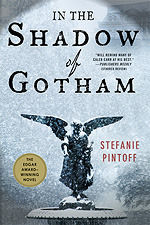 Set in 1905, in Dobson, New York. Stefanie Pintoff's debut novel, In the Shadow of Gotham, was the recipient of the Edgar Award for Best First Novel. The story opens with the murder of a graduate student, young Sarah Wingate, victim of a particularly brutal attack. When a researcher from Columbia, where the victim worked, calls Detective Simon Ziele, claiming he knows the killer's identity, the book takes off. From the opening chapter, the reader follows Detective Ziele through a labyrinth of false leads and tantalizingly close incidents. Gambling halls, a house of prostitution, and a coroner's wagon all serve to bring early twentieth-century New York alive, even as time is running out for the killer's next victim.
Set in 1905, in Dobson, New York. Stefanie Pintoff's debut novel, In the Shadow of Gotham, was the recipient of the Edgar Award for Best First Novel. The story opens with the murder of a graduate student, young Sarah Wingate, victim of a particularly brutal attack. When a researcher from Columbia, where the victim worked, calls Detective Simon Ziele, claiming he knows the killer's identity, the book takes off. From the opening chapter, the reader follows Detective Ziele through a labyrinth of false leads and tantalizingly close incidents. Gambling halls, a house of prostitution, and a coroner's wagon all serve to bring early twentieth-century New York alive, even as time is running out for the killer's next victim.Well written and full of historical details, In the Shadow of Gotham is a page turner that is sure to please any reader who likes a touch of history with their mystery.
Published on April 21, 2011 17:58
March 28, 2011
Sanitation in 19th Century Europe
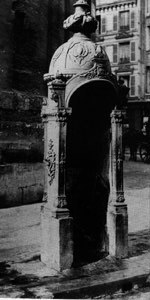 Decorated Urinal in Paris 1870The industrial revolution in Europe attracted workers to urban centers, creating large, overcrowded slums in the cities. Wealthier citizen fled to residential areas outside the cities, abandoning their houses. The poor moved in, living often in homes vacated by the rich. Rooms were continually divided, making way in a structure for more families. Floors were added with low ceilings. Stairs frequently were only ladders.
Decorated Urinal in Paris 1870The industrial revolution in Europe attracted workers to urban centers, creating large, overcrowded slums in the cities. Wealthier citizen fled to residential areas outside the cities, abandoning their houses. The poor moved in, living often in homes vacated by the rich. Rooms were continually divided, making way in a structure for more families. Floors were added with low ceilings. Stairs frequently were only ladders. Few cesspools were in use, and water was only available in the streets. This contributed to frequent outbreaks of cholera and tuberculosis in the slums, where many people lived in houses with narrow streets and little sunlight.
Gradually, fountains, sewers, urinals, and fire hydrants were constructed. By the 1860s, horse drawn tipcarts were used to collect garbage from sidewalks, where it had been dumped the night before for collection.
In the 1880s cesspools became more popular, sometimes by decree, and in spite of organized protests by cesspool cleaners and some unlikely colleagues, medical men. Louis Pasteur wanted sewage to be dumped into the sea because he believed cesspool treatment did not kill enough of the organisms that caused infection.
When garbage cans came into use, outbreaks of typhoid and cholera became less frequent and killed fewer people. In the late 19th century, as the benefits of fresh water, sewers, and garbage collection became common knowledge, health and life expectancy improved dramatically.
Published on March 28, 2011 19:11
March 11, 2011
Bed Wagons
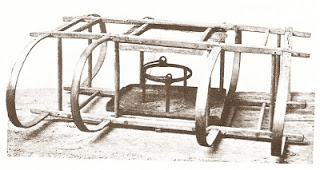 Large bed wagon
Large bed wagon
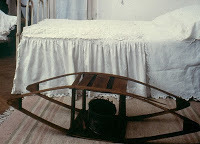 Bed wagon Bed wagons were used throughout history, to ease the chores of a servant, assigned to keep her master's and mistress' bed warm. Ofttimes, before the invention of the wagons, warming pans were rushed to and fro, from fireside to bedchamber, and slid between the bed covers to chase away the chill of an unheated room.
Bed wagon Bed wagons were used throughout history, to ease the chores of a servant, assigned to keep her master's and mistress' bed warm. Ofttimes, before the invention of the wagons, warming pans were rushed to and fro, from fireside to bedchamber, and slid between the bed covers to chase away the chill of an unheated room.
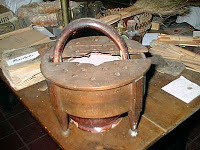 Fuel pot
Fuel pot
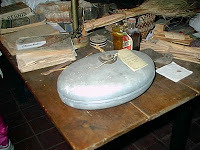 Metal fuel holder With the invention of a bed wagon, the task of bed warming became easier. The contrivance was made of bent hoops, either iron or wood, which held the covers away from the heat, and made the job of warming a large bed less labor-intensive. The frames of bed wagons were usually made of ash, but sometimes of oak. The total length was normally three feet or longer, enough to ensure that most of the bed area was warmed. A pot of burning fuel was placed in a trivet built into the middle of the frame. An iron sheet was attached to the frame, directly beneath the trivet, to prevent any scorching of the bed linens. Above the pot, situated between two of the hoops, another metal sheet guarded against the coverlets catching fire. Sometimes, the pot of fuel was hung from the top of the wagon, suspended in the approximate middle of the frame. Pots could be made of iron, brass, or earthenware, with or without a lid. If unlidded, ashes might cover the surface of the fuel.
Metal fuel holder With the invention of a bed wagon, the task of bed warming became easier. The contrivance was made of bent hoops, either iron or wood, which held the covers away from the heat, and made the job of warming a large bed less labor-intensive. The frames of bed wagons were usually made of ash, but sometimes of oak. The total length was normally three feet or longer, enough to ensure that most of the bed area was warmed. A pot of burning fuel was placed in a trivet built into the middle of the frame. An iron sheet was attached to the frame, directly beneath the trivet, to prevent any scorching of the bed linens. Above the pot, situated between two of the hoops, another metal sheet guarded against the coverlets catching fire. Sometimes, the pot of fuel was hung from the top of the wagon, suspended in the approximate middle of the frame. Pots could be made of iron, brass, or earthenware, with or without a lid. If unlidded, ashes might cover the surface of the fuel.
Italian and French bed-wagons were commonly called a 'monk' or a 'priest', no doubt another bed-humor reference like the English joke that a housemaid was a "Scotch warming pan".

 Large bed wagon
Large bed wagon
 Bed wagon Bed wagons were used throughout history, to ease the chores of a servant, assigned to keep her master's and mistress' bed warm. Ofttimes, before the invention of the wagons, warming pans were rushed to and fro, from fireside to bedchamber, and slid between the bed covers to chase away the chill of an unheated room.
Bed wagon Bed wagons were used throughout history, to ease the chores of a servant, assigned to keep her master's and mistress' bed warm. Ofttimes, before the invention of the wagons, warming pans were rushed to and fro, from fireside to bedchamber, and slid between the bed covers to chase away the chill of an unheated room.
 Fuel pot
Fuel pot
 Metal fuel holder With the invention of a bed wagon, the task of bed warming became easier. The contrivance was made of bent hoops, either iron or wood, which held the covers away from the heat, and made the job of warming a large bed less labor-intensive. The frames of bed wagons were usually made of ash, but sometimes of oak. The total length was normally three feet or longer, enough to ensure that most of the bed area was warmed. A pot of burning fuel was placed in a trivet built into the middle of the frame. An iron sheet was attached to the frame, directly beneath the trivet, to prevent any scorching of the bed linens. Above the pot, situated between two of the hoops, another metal sheet guarded against the coverlets catching fire. Sometimes, the pot of fuel was hung from the top of the wagon, suspended in the approximate middle of the frame. Pots could be made of iron, brass, or earthenware, with or without a lid. If unlidded, ashes might cover the surface of the fuel.
Metal fuel holder With the invention of a bed wagon, the task of bed warming became easier. The contrivance was made of bent hoops, either iron or wood, which held the covers away from the heat, and made the job of warming a large bed less labor-intensive. The frames of bed wagons were usually made of ash, but sometimes of oak. The total length was normally three feet or longer, enough to ensure that most of the bed area was warmed. A pot of burning fuel was placed in a trivet built into the middle of the frame. An iron sheet was attached to the frame, directly beneath the trivet, to prevent any scorching of the bed linens. Above the pot, situated between two of the hoops, another metal sheet guarded against the coverlets catching fire. Sometimes, the pot of fuel was hung from the top of the wagon, suspended in the approximate middle of the frame. Pots could be made of iron, brass, or earthenware, with or without a lid. If unlidded, ashes might cover the surface of the fuel.Italian and French bed-wagons were commonly called a 'monk' or a 'priest', no doubt another bed-humor reference like the English joke that a housemaid was a "Scotch warming pan".
Published on March 11, 2011 12:34
February 17, 2011
Medieval Beds
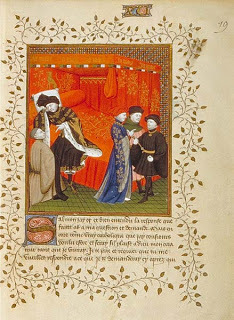 In the 14th century, peasants slept on straw mats, covered with anything available, while the rich slept on featherbeds and linen sheets. A nobleman's bed had canopies with rich hangings, sometimes embroidered with his shield. Beds were a gathering place in wealthy homes, and were used not only for sleeping but to receive guests, who, if very important, might be invited to sleep in the bed, even if they had to share. Thus, beds were the most important piece of furniture, a place to display wealth as evidenced with fine textiles.
In the 14th century, peasants slept on straw mats, covered with anything available, while the rich slept on featherbeds and linen sheets. A nobleman's bed had canopies with rich hangings, sometimes embroidered with his shield. Beds were a gathering place in wealthy homes, and were used not only for sleeping but to receive guests, who, if very important, might be invited to sleep in the bed, even if they had to share. Thus, beds were the most important piece of furniture, a place to display wealth as evidenced with fine textiles.
 Birth of Louis VIII
Birth of Louis VIII A head sheet, as shown in the Birth of Louis VIII image, was placed over a pillow that rested against a sheet-draped bolster. Around the 16th century, these head sheets were replaced by pillowcases.
The best beds in the late Middle Ages had fabrics draped from a frame suspended from the ceiling. The frame sometimes had additional support from a bedhead. The bed itself was not usually attached to the bedhead. Beds were often set on platforms to extend the elevation, making a step up necessary.
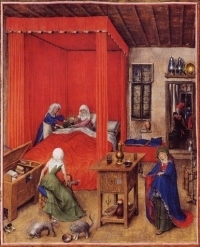
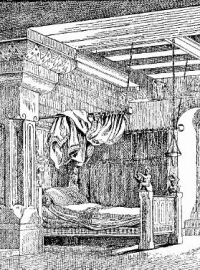 From the 14th century on, beds were mentioned in wills. A fairly well-off family might pass down a featherbed and feather-filled bolster, but a noble family might give several beds to his descendants, along with the expensive hangings and a woolen mattress.
From the 14th century on, beds were mentioned in wills. A fairly well-off family might pass down a featherbed and feather-filled bolster, but a noble family might give several beds to his descendants, along with the expensive hangings and a woolen mattress.In later centuries, as people became better-off, they wanted better beds, and soon beds were a standard in most homes. Except for the head sheet, beds themselves have not changed that much. What has changed is the way we use them. We would never invite a guest, no matter his social standing, to share our beds, and instead of a gathering place for guests, our beds have become the most private piece of furniture in our homes.
Published on February 17, 2011 18:55
February 4, 2011
Timely Trains and Tasty Treats, or Strange Name for a Train
In a scene in my work-in-progress, my characters take a train from Baden to Zurich. In doing research, I discovered a delightful piece of 19th century history.
 A Baden specialtyWhile surrounding countries built railroads in order to move people and commerce more economically, the Swiss resisted, not only for geographical reasons (the mountains) but also because land owners did not want to part with their land. Finally, in August of 1847, the first rail line was opened in Switzerland by the Swiss Northern Railway system. The train ran from Zurich to Baden, a distance of twenty kilometers. It took forty-five minutes, making two stops along the way.
A Baden specialtyWhile surrounding countries built railroads in order to move people and commerce more economically, the Swiss resisted, not only for geographical reasons (the mountains) but also because land owners did not want to part with their land. Finally, in August of 1847, the first rail line was opened in Switzerland by the Swiss Northern Railway system. The train ran from Zurich to Baden, a distance of twenty kilometers. It took forty-five minutes, making two stops along the way.
Baden was famous for its Spanish rolls, which originated in Milan during the 17th century, when the city was under Spanish control. Later, under the laws of the Swiss canton, these rolls could only be distributed within Switzerland from Baden.
Before railroads came to Switzerland, the gentry of Zurich, eager to impress their clients at Sunday teas, sent their servants to Baden to buy the popular rolls. The servants then had to leave Baden at midnight, in order to have the rolls back in Zurich in time for Sunday morning teas.
With the opening of the rail line between the two cities, servants were sent on the train to buy the buns, bringing the delectable sweets back to Zurich, still warm. The train became known over time as the Spanisch-Brötli-Bahn, the Spanish bun train.
To me, the rolls look a little like hot cross buns, with maybe some kind of filling. No matter. If I ever visit Switzerland, I'm certainly going to buy a Spanish bun.

 A Baden specialtyWhile surrounding countries built railroads in order to move people and commerce more economically, the Swiss resisted, not only for geographical reasons (the mountains) but also because land owners did not want to part with their land. Finally, in August of 1847, the first rail line was opened in Switzerland by the Swiss Northern Railway system. The train ran from Zurich to Baden, a distance of twenty kilometers. It took forty-five minutes, making two stops along the way.
A Baden specialtyWhile surrounding countries built railroads in order to move people and commerce more economically, the Swiss resisted, not only for geographical reasons (the mountains) but also because land owners did not want to part with their land. Finally, in August of 1847, the first rail line was opened in Switzerland by the Swiss Northern Railway system. The train ran from Zurich to Baden, a distance of twenty kilometers. It took forty-five minutes, making two stops along the way.Baden was famous for its Spanish rolls, which originated in Milan during the 17th century, when the city was under Spanish control. Later, under the laws of the Swiss canton, these rolls could only be distributed within Switzerland from Baden.
Before railroads came to Switzerland, the gentry of Zurich, eager to impress their clients at Sunday teas, sent their servants to Baden to buy the popular rolls. The servants then had to leave Baden at midnight, in order to have the rolls back in Zurich in time for Sunday morning teas.
With the opening of the rail line between the two cities, servants were sent on the train to buy the buns, bringing the delectable sweets back to Zurich, still warm. The train became known over time as the Spanisch-Brötli-Bahn, the Spanish bun train.
To me, the rolls look a little like hot cross buns, with maybe some kind of filling. No matter. If I ever visit Switzerland, I'm certainly going to buy a Spanish bun.
Published on February 04, 2011 18:26
January 15, 2011
Marking Time: Royalty, Monks, and Geishas
 Hourglass One of my favorite props, to convey the atmosphere in a room, or a character's thoughts, is a clock. A timepiece can set the mood while a character writes a letter. In my work-in-progress, set in the 1800s, a girl writes to her father. The ticking of the wall clock, interrupted only by a bell sounding the half-hour, sets the mood. To indicate impatience or boredom, one glance at a clock will let the reader know the character's thoughts. Here are some interesting facts I've come across, while researching timepieces.
Hourglass One of my favorite props, to convey the atmosphere in a room, or a character's thoughts, is a clock. A timepiece can set the mood while a character writes a letter. In my work-in-progress, set in the 1800s, a girl writes to her father. The ticking of the wall clock, interrupted only by a bell sounding the half-hour, sets the mood. To indicate impatience or boredom, one glance at a clock will let the reader know the character's thoughts. Here are some interesting facts I've come across, while researching timepieces.
In ancient times, sundials displayed the time of day, but because this method needed shadows for time telling, one would have to guess at the hour on cloudy days.
The earliest indoor timekeeping devices were water clocks and hour glasses, whose function was similar: a controlled amount of substance escaped a container, a measure of the amount released marking the passage of time.
With the advent of Christianity, calendars, prominent in monasteries, reminded the monks of Feast Days, of which there were plenty. Church bells wakened the citizens, whereupon they set out for daily tasks. Less important for peasants and commoners during the Middle Ages, timepieces were made with the nobility in mind, because workers began their day with the rising sun, and went to bed at dark.
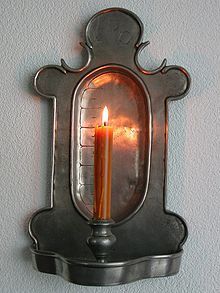 Candle Clock One of the most charming, yet one of the simplest devices used, was the candle clock, which was designed to tell time at night. One of the ways a candle clock could be employed was to note the period of time it took a candle of controlled size and substance to burn to a certain length. Marks behind the candle, such as is illustrated in the picture to the right, would designate the passing hours as the candle burned.
Candle Clock One of the most charming, yet one of the simplest devices used, was the candle clock, which was designed to tell time at night. One of the ways a candle clock could be employed was to note the period of time it took a candle of controlled size and substance to burn to a certain length. Marks behind the candle, such as is illustrated in the picture to the right, would designate the passing hours as the candle burned.
Along with water and sand, incense was also used for timekeeping. In Japan, as late as 1924, geishas were paid by the number of incense sticks that had burned down.
In the early 1300s, the mechanical clock was invented in Europe, although the Arabs had used a system of gears and weights in their water clocks as early as the 11th century. During the 14th century, an escapement mechanism was devised, and two centuries later, clocks and pocket watches were spring-powered. Later, the pendulum came into use, an example of that slow, mesmerizing movement we see in longcase clocks.

 Hourglass One of my favorite props, to convey the atmosphere in a room, or a character's thoughts, is a clock. A timepiece can set the mood while a character writes a letter. In my work-in-progress, set in the 1800s, a girl writes to her father. The ticking of the wall clock, interrupted only by a bell sounding the half-hour, sets the mood. To indicate impatience or boredom, one glance at a clock will let the reader know the character's thoughts. Here are some interesting facts I've come across, while researching timepieces.
Hourglass One of my favorite props, to convey the atmosphere in a room, or a character's thoughts, is a clock. A timepiece can set the mood while a character writes a letter. In my work-in-progress, set in the 1800s, a girl writes to her father. The ticking of the wall clock, interrupted only by a bell sounding the half-hour, sets the mood. To indicate impatience or boredom, one glance at a clock will let the reader know the character's thoughts. Here are some interesting facts I've come across, while researching timepieces.In ancient times, sundials displayed the time of day, but because this method needed shadows for time telling, one would have to guess at the hour on cloudy days.
The earliest indoor timekeeping devices were water clocks and hour glasses, whose function was similar: a controlled amount of substance escaped a container, a measure of the amount released marking the passage of time.
With the advent of Christianity, calendars, prominent in monasteries, reminded the monks of Feast Days, of which there were plenty. Church bells wakened the citizens, whereupon they set out for daily tasks. Less important for peasants and commoners during the Middle Ages, timepieces were made with the nobility in mind, because workers began their day with the rising sun, and went to bed at dark.
 Candle Clock One of the most charming, yet one of the simplest devices used, was the candle clock, which was designed to tell time at night. One of the ways a candle clock could be employed was to note the period of time it took a candle of controlled size and substance to burn to a certain length. Marks behind the candle, such as is illustrated in the picture to the right, would designate the passing hours as the candle burned.
Candle Clock One of the most charming, yet one of the simplest devices used, was the candle clock, which was designed to tell time at night. One of the ways a candle clock could be employed was to note the period of time it took a candle of controlled size and substance to burn to a certain length. Marks behind the candle, such as is illustrated in the picture to the right, would designate the passing hours as the candle burned.Along with water and sand, incense was also used for timekeeping. In Japan, as late as 1924, geishas were paid by the number of incense sticks that had burned down.
In the early 1300s, the mechanical clock was invented in Europe, although the Arabs had used a system of gears and weights in their water clocks as early as the 11th century. During the 14th century, an escapement mechanism was devised, and two centuries later, clocks and pocket watches were spring-powered. Later, the pendulum came into use, an example of that slow, mesmerizing movement we see in longcase clocks.
Published on January 15, 2011 13:52
January 7, 2011
My Binge on Historical Novels
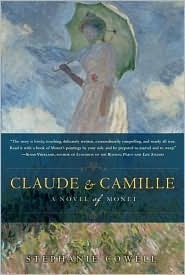 For a while, beginning shortly after the release of my historical novel, The Tapestry Shop, I was busy with promotion. That, along with finishing another manuscript, kept me going at full speed. Finally, over the holidays, I took time to do some serious reading, and this time it wasn't for research, but for pure enjoyment.
For a while, beginning shortly after the release of my historical novel, The Tapestry Shop, I was busy with promotion. That, along with finishing another manuscript, kept me going at full speed. Finally, over the holidays, I took time to do some serious reading, and this time it wasn't for research, but for pure enjoyment.For anyone who enjoys biographical fiction, be sure to pick up a copy of Claude and Camille: A Novel of Monet, by Stephanie Cowell. Monet's life and times come alive in her skillful use of visualization, and I learned a lot about him and the artists whose names we now associate with Impressionism.
Mistress Anne was the first Carolly Erickson novel I read, and I was hooked. I had been longing to read another two of hers: The Tsarina's Daughter and The Hidden Diary of Marie Antoinette. Erickson's books just keep getting better. These last two were a real treat. I kept turning the pages, dreading the end when I would have to leave the Romanov family behind at the end of The Tsarina's Daughter. The Hidden Diaries left me wishing there were a few more pages. This book shows us another portrait of Marie Antoinette and a different look at the world and people around her. The reader is almost blinded by the gold reflection from the chandeliers at Versailles, and the vivid imagery makes you want to put on your dancing shoes and join the crowd in the glittering ballroom, even though you know the music has to end.
Published on January 07, 2011 17:30
January 3, 2011
Shipwrecks, Crime, and the Frisbee Invention
Tuesday, Jan. 4th on the Travel Channel, you'll see some informative episodes about American history. The series is called Mysteries at the Museum. There's something for everyone this week whether you like history, old cars, or crime scenes. Here's a taste of what they have planned:
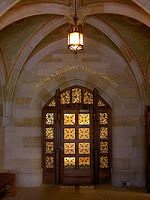 Entrance to the Music Library at Yale Museum of the City of New York: No story is bigger than the attacks of September 11, 2001. But 9/11 wasn't the first time an airplane flew into a New York City skyscraper. Within the Museum of the City of New York, there is one artifact that tells the incredible and largely forgotten story of another incident that brought dread and destruction to this city.
Entrance to the Music Library at Yale Museum of the City of New York: No story is bigger than the attacks of September 11, 2001. But 9/11 wasn't the first time an airplane flew into a New York City skyscraper. Within the Museum of the City of New York, there is one artifact that tells the incredible and largely forgotten story of another incident that brought dread and destruction to this city.
National Museum of Crime and Punishment: At the National Museum of Crime and Punishment in Washington, DC there is one particularly chilling artifact. It's a plaster mould of a man's face, made with impressive precision. It's called a "death mask" and it was cast directly from the corpse of a notorious bank robber. According to the FBI this death mask is proof that they gunned down a man once known as "public enemy number one"… John Dillinger. But, to people that knew the elusive outlaw, the resemblance between the death mask and the man is no dead certainty.
National Automobile Museum: At the National Automobile Museum in Reno, Nevada, there's a beat up, old-fashioned car known as the Thomas Flyer. Its seats are perched high behind the steering wheel and there's no roof, no windows and no windshield. This four-cylinder, sixty horsepower car traversed the globe in one of the most grueling car races ever conceived. In the process, this singular 1907 car shattered the way the world looked at automobiles.
Great Lakes Shipwreck Museum: In Paradise, Michigan, the Great Lakes Shipwreck Museum displays artifacts from numerous ships that have been lost on America's great inland seas. But, one artifact ,a two hundred pound bronze bell that once sat on the deck of the SS Edmund Fitzgerald, is a somber reminder of the greatest enigma in Great Lakes History. What exactly happened on the Edmund Fitzgerald's perplexing and tragic final journey?
Sterling Memorial Library at Yale: In New Haven, Connecticut, the grand library of Yale University holds a surprisingly modest artifact. This simple metal pie plate inspired one of the most used, most loved and most widespread toys of all time, the Frisbee. How did a pie maker, a UFO fanatic, and some Yale students all come together to invent one of the world's most popular toys and sports?
Gerald R. Ford Museum: Inside the Gerald R. Ford Museum in Grand Rapids, Michigan, some 18,000 artifacts celebrate Ford's contributions as a statesman and US President. But, there's one artifact here that haunted President Ford until the day he died. It's a 15-foot high metal staircase and it symbolizes one of most controversial and tragic moments in US History – the Fall of Saigon. How did this staircase become a lifeline to thousands and close the door on one of America's longest and most bitter conflicts?
 Entrance to the Music Library at Yale Museum of the City of New York: No story is bigger than the attacks of September 11, 2001. But 9/11 wasn't the first time an airplane flew into a New York City skyscraper. Within the Museum of the City of New York, there is one artifact that tells the incredible and largely forgotten story of another incident that brought dread and destruction to this city.
Entrance to the Music Library at Yale Museum of the City of New York: No story is bigger than the attacks of September 11, 2001. But 9/11 wasn't the first time an airplane flew into a New York City skyscraper. Within the Museum of the City of New York, there is one artifact that tells the incredible and largely forgotten story of another incident that brought dread and destruction to this city. National Museum of Crime and Punishment: At the National Museum of Crime and Punishment in Washington, DC there is one particularly chilling artifact. It's a plaster mould of a man's face, made with impressive precision. It's called a "death mask" and it was cast directly from the corpse of a notorious bank robber. According to the FBI this death mask is proof that they gunned down a man once known as "public enemy number one"… John Dillinger. But, to people that knew the elusive outlaw, the resemblance between the death mask and the man is no dead certainty.
National Automobile Museum: At the National Automobile Museum in Reno, Nevada, there's a beat up, old-fashioned car known as the Thomas Flyer. Its seats are perched high behind the steering wheel and there's no roof, no windows and no windshield. This four-cylinder, sixty horsepower car traversed the globe in one of the most grueling car races ever conceived. In the process, this singular 1907 car shattered the way the world looked at automobiles.
Great Lakes Shipwreck Museum: In Paradise, Michigan, the Great Lakes Shipwreck Museum displays artifacts from numerous ships that have been lost on America's great inland seas. But, one artifact ,a two hundred pound bronze bell that once sat on the deck of the SS Edmund Fitzgerald, is a somber reminder of the greatest enigma in Great Lakes History. What exactly happened on the Edmund Fitzgerald's perplexing and tragic final journey?
Sterling Memorial Library at Yale: In New Haven, Connecticut, the grand library of Yale University holds a surprisingly modest artifact. This simple metal pie plate inspired one of the most used, most loved and most widespread toys of all time, the Frisbee. How did a pie maker, a UFO fanatic, and some Yale students all come together to invent one of the world's most popular toys and sports?
Gerald R. Ford Museum: Inside the Gerald R. Ford Museum in Grand Rapids, Michigan, some 18,000 artifacts celebrate Ford's contributions as a statesman and US President. But, there's one artifact here that haunted President Ford until the day he died. It's a 15-foot high metal staircase and it symbolizes one of most controversial and tragic moments in US History – the Fall of Saigon. How did this staircase become a lifeline to thousands and close the door on one of America's longest and most bitter conflicts?
Published on January 03, 2011 12:21
December 26, 2010
Greetings and a great season to my readers. Here, for mor...
Greetings and a great season to my readers. Here, for more holiday enjoyment, is the next episode of Mysteries at the Museum. This show will air on The Travel Channel on Tuesday, Dec. 28.
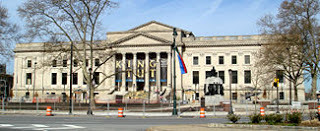 Franklin Institute Franklin Institute: The Franklin Institute holds one of the first electronic instruments, but this warbling wonder is more than just a footnote in musical history. How did this play a part in triggering one of the biggest spy scandals of the century?
Franklin Institute Franklin Institute: The Franklin Institute holds one of the first electronic instruments, but this warbling wonder is more than just a footnote in musical history. How did this play a part in triggering one of the biggest spy scandals of the century?
Washington State History Museum: On display at the Washington State History Museum is a 600 lb hunk of concrete with a disastrous past. More than a piece of junkyard scrap, this is a remnant from one of the most catastrophic engineering failures in U.S. history: the collapse of the Tacoma Narrows Bridge. How did this state of the art bridge fail so spectacularly?
Strong Museum of Play: At the Strong Museum of Play in Rochester, New York, poised amongst history's greatest toys, is a small plastic egg filled with some beloved bouncing goo: Silly Putty. Did you know that this sensational children's novelty originated from a war shortage?
Detroit Science Center: On display at the Detroit Science Center is a truly macabre exhibit: 36 men, women and children that died two centuries ago are mysteriously preserved. But they aren't the carefully prepared mummies of Egyptian royalty. These bodies were preserved by something else – and for decades science has struggled to figure out how… until now.
Johnston Ridge Observatory: At the Johnston Observatory in Gifford Pinchot National Forrest, the splintered remains of what was once a mighty 100 foot Hemlock tree stands as a visceral reminder. Like millions of other trees, it was napped like a toothpick by a blast 1600 times more powerful than an atom bomb. What's capable of such a tremendous explosion?
Mariner's Museum: At the Mariners' Museum in Newport ,Virginia, thousands of artifacts chronicle man's relationship with the sea. But one artifact, an ordinary supply box, speaks of the sea's tremendous and mysterious powers. The box belonged to the USS Cyclops, a colossal ship that has since passed into legend. What happened to this notorious ship, and does this box hold any answers?
For all of you I'm wishing a happy and prosperous 2011.

 Franklin Institute Franklin Institute: The Franklin Institute holds one of the first electronic instruments, but this warbling wonder is more than just a footnote in musical history. How did this play a part in triggering one of the biggest spy scandals of the century?
Franklin Institute Franklin Institute: The Franklin Institute holds one of the first electronic instruments, but this warbling wonder is more than just a footnote in musical history. How did this play a part in triggering one of the biggest spy scandals of the century?Washington State History Museum: On display at the Washington State History Museum is a 600 lb hunk of concrete with a disastrous past. More than a piece of junkyard scrap, this is a remnant from one of the most catastrophic engineering failures in U.S. history: the collapse of the Tacoma Narrows Bridge. How did this state of the art bridge fail so spectacularly?
Strong Museum of Play: At the Strong Museum of Play in Rochester, New York, poised amongst history's greatest toys, is a small plastic egg filled with some beloved bouncing goo: Silly Putty. Did you know that this sensational children's novelty originated from a war shortage?
Detroit Science Center: On display at the Detroit Science Center is a truly macabre exhibit: 36 men, women and children that died two centuries ago are mysteriously preserved. But they aren't the carefully prepared mummies of Egyptian royalty. These bodies were preserved by something else – and for decades science has struggled to figure out how… until now.
Johnston Ridge Observatory: At the Johnston Observatory in Gifford Pinchot National Forrest, the splintered remains of what was once a mighty 100 foot Hemlock tree stands as a visceral reminder. Like millions of other trees, it was napped like a toothpick by a blast 1600 times more powerful than an atom bomb. What's capable of such a tremendous explosion?
Mariner's Museum: At the Mariners' Museum in Newport ,Virginia, thousands of artifacts chronicle man's relationship with the sea. But one artifact, an ordinary supply box, speaks of the sea's tremendous and mysterious powers. The box belonged to the USS Cyclops, a colossal ship that has since passed into legend. What happened to this notorious ship, and does this box hold any answers?
For all of you I'm wishing a happy and prosperous 2011.
Published on December 26, 2010 12:55
December 18, 2010
More Mysteries for Holiday Watching
Tuesday Dec. 21 brings an exciting new episode on the Travel Channel's series on Mysteries at the Museum: This is Volume 7 of the series. Take a moment to sit back, put your feet up, and enjoy some of our unique history that you
didn't know about. It might be right next door.
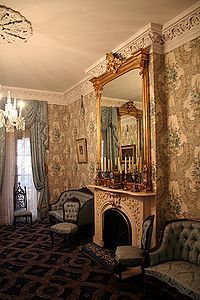 Theodore Roosevelt's sitting room Theodore Roosevelt Birthplace, National Historic Site: Tucked away on the east side of Manhattan is Theodore Roosevelt's childhood home. Inside are two particular artifacts on display that had a bigger impact on Roosevelt's life than any other. Both of these artifacts share a strange feature, and saved the life of one of America's greatest statesmen.
Theodore Roosevelt's sitting room Theodore Roosevelt Birthplace, National Historic Site: Tucked away on the east side of Manhattan is Theodore Roosevelt's childhood home. Inside are two particular artifacts on display that had a bigger impact on Roosevelt's life than any other. Both of these artifacts share a strange feature, and saved the life of one of America's greatest statesmen.
The Western Reserve Historical Society: The Western Reserve Historical Society carefully preserves Cleveland's legacy, but one set of the museum's artifacts remains shrouded in mystery. They are five postcards from the 1950's that hold a distinctly taunting tone. Who wrote them and why? The story starts in the midst of one of the worst killing sprees in American history…
Museum of Science and Industry: Inside Chicago's Museum of Science and Industry, there's a vehicle that resembles a space hip or rocket, but it's neither. In the 1960's this amazing automobile helped a young California hot rod driver do something no one had ever done before- travel over 407 mph on land.
Titanic Historical Society: In Massachusetts there's a museum that is dedicated to shedding new light on the ill-fated voyage of the world's most famous ocean liner. Inside this official Titanic museum there is a single faded piece of paper. Do you know why this wireless telegram was unable to save the Titanic from her tragic fate?
Henry Ford Museum: On the outskirts of Detroit, the famed motor city, is the Henry Ford Museum. On display is a simple yellow city bus where visitors can see for themselves the very seat where Rosa Parks took a historical stand, by simply sitting down. But this story didn't play out the way most of believe…
Big Foot Discovery Museum: Nestled in the heart of Northern California's epic red wood forests is a museum dedicated to the region's most famous alleged inhabitant, Big Foot. Can a recently discovered primate tooth put an end to the age old debate of whether or not big foot is real?
To all my readers, may your holidays bring health and happiness.
didn't know about. It might be right next door.
 Theodore Roosevelt's sitting room Theodore Roosevelt Birthplace, National Historic Site: Tucked away on the east side of Manhattan is Theodore Roosevelt's childhood home. Inside are two particular artifacts on display that had a bigger impact on Roosevelt's life than any other. Both of these artifacts share a strange feature, and saved the life of one of America's greatest statesmen.
Theodore Roosevelt's sitting room Theodore Roosevelt Birthplace, National Historic Site: Tucked away on the east side of Manhattan is Theodore Roosevelt's childhood home. Inside are two particular artifacts on display that had a bigger impact on Roosevelt's life than any other. Both of these artifacts share a strange feature, and saved the life of one of America's greatest statesmen.The Western Reserve Historical Society: The Western Reserve Historical Society carefully preserves Cleveland's legacy, but one set of the museum's artifacts remains shrouded in mystery. They are five postcards from the 1950's that hold a distinctly taunting tone. Who wrote them and why? The story starts in the midst of one of the worst killing sprees in American history…
Museum of Science and Industry: Inside Chicago's Museum of Science and Industry, there's a vehicle that resembles a space hip or rocket, but it's neither. In the 1960's this amazing automobile helped a young California hot rod driver do something no one had ever done before- travel over 407 mph on land.
Titanic Historical Society: In Massachusetts there's a museum that is dedicated to shedding new light on the ill-fated voyage of the world's most famous ocean liner. Inside this official Titanic museum there is a single faded piece of paper. Do you know why this wireless telegram was unable to save the Titanic from her tragic fate?
Henry Ford Museum: On the outskirts of Detroit, the famed motor city, is the Henry Ford Museum. On display is a simple yellow city bus where visitors can see for themselves the very seat where Rosa Parks took a historical stand, by simply sitting down. But this story didn't play out the way most of believe…
Big Foot Discovery Museum: Nestled in the heart of Northern California's epic red wood forests is a museum dedicated to the region's most famous alleged inhabitant, Big Foot. Can a recently discovered primate tooth put an end to the age old debate of whether or not big foot is real?
To all my readers, may your holidays bring health and happiness.
Published on December 18, 2010 18:21



